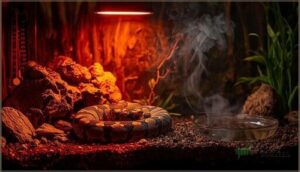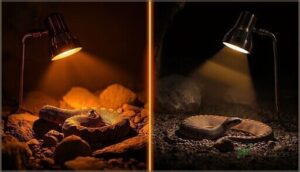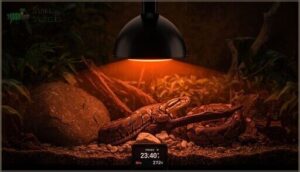This site is supported by our readers. We may earn a commission, at no cost to you, if you purchase through links.
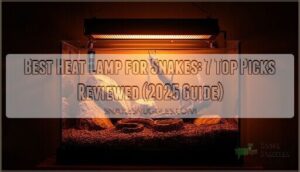
You can’t just slap any bulb into a fixture and call it good. Your enclosure size, substrate type, and thermostat compatibility determine which option works best. Proper placement creates that essential thermal gradient your snake needs to thermoregulate naturally.
The wrong choice leads to burns, stress, or worse—but the right setup becomes your pet’s lifeline to healthy digestion and behavior.
Table Of Contents
- Key Takeaways
- Choosing The Best Heat Lamp for Snakes
- Why Snakes Need Proper Heat Lamps
- Key Factors When Selecting a Heat Lamp
- Types of Heat Lamps for Snake Enclosures
- Top 7 Best Heat Lamps for Snakes
- Heat Lamp Safety and Maintenance Tips
- Creating an Ideal Snake Habitat
- Frequently Asked Questions (FAQs)
- How to choose a heat lamp for snakes?
- What kind of light does a snake need?
- Do Reptiles need a heating lamp?
- Why should you choose a ceramic lamp for a snake enclosure?
- How much does a snake lamp cost?
- How Often Should I Be Cleaning the Lamps and Fixtures?
- Is a Thermostat Necessary for Heat Lamps and Heat Mats?
- What is the price range for a reptile heat lamp?
- Why do snakes need heat lamps?
- How can I keep my reptile warm at night?
- Conclusion
Key Takeaways
- You’ll need to match your heat lamp choice to your snake’s specific species requirements – ball pythons thrive with halogen bulbs maintaining 88-96°F basking zones, while corn snakes prefer incandescent sources at 85-90°F.
- Safety isn’t optional when it comes to heat lamps – you must use a thermostat to prevent dangerous overheating, install lamp guards to avoid burns, and maintain proper distance (12-18 inches) between the bulb and your snake’s basking area.
- Creating the right thermal gradient matters more than just providing heat – position your lamp at one end to establish a warm basking zone, then let temperatures drop 10-15°F toward the cool side so your snake can thermoregulate naturally.
- Consider ceramic heat emitters or deep heat projectors for 24/7 heating without disrupting your snake’s sleep cycle – these provide consistent infrared warmth without visible light that can stress nocturnal species.
Choosing The Best Heat Lamp for Snakes
You’ll want to match your heat lamp choice to your snake’s specific needs – things like species size, natural habitat, and how big your enclosure is.
A good lamp sets up the right temperature zones while giving off safe infrared heat that feels like natural sunlight, the same warmth your snake would soak up in its native environment.
Matching Lamp Type to Snake Species
Getting the right heat lamp for your snake doesn’t have to be complicated, but it makes all the difference in keeping them healthy. Ball pythons do best with halogen bulbs that mimic their natural environment, while corn snakes prefer good old incandescent heat sources. The type of lamp you choose will affect how your snake basks and regulates its body temperature.
Here’s what works for different species:
- Ball pythons – Go with halogen or infrared lamps (keep basking spots at 88-96°F)
- Corn snakes – Stick with incandescent bulbs (aim for 85-90°F on the warm side)
- Larger species – Use multiple flood lamps to spread heat evenly
Corn snakes also benefit from low-intensity UVB light to really thrive.
Understanding Infrared Radiation Benefits
Infrared radiation benefits your snake’s health like sunshine benefits you. This invisible heat penetrates deeper than regular bulbs, supporting digestion and natural behavior.
Infrared-A wavelengths provide sun-like heating that promotes reptile wellness. Your snake’s body reacts to these infrared types by boosting metabolism and immune function.
Quality reptile heating mimics nature’s blueprint, making infrared light the ideal choice for heat lamps.
Importance of a Thermal Gradient
Think of your snake’s enclosure like a house with different rooms – each serving a purpose. Creating a proper temperature gradient means establishing both a basking zone and cool zone for best thermoregulation. Your snake’s behavior and health benefits depend on this thermal regulation system working correctly.
Here’s why enclosure temperature matters:
- Basking Zone Setup – Position heat lamp at one end, maintaining 85-95°F for digestion and activity.
- Cool Zone Creation – Keep opposite end 75-80°F for rest and stress relief.
- Thermostat Integration – Use automatic controllers to prevent dangerous temperature spikes.
- Behavioral Observation – Watch snake movement patterns between zones for health monitoring.
- Reptile Care Standards – Follow species-specific temperature requirements for best wellness.
Why Snakes Need Proper Heat Lamps
Your snake can’t regulate its body temperature like you can, making proper heat lamps essential for survival, digestion, and overall health.
Without adequate warmth, you’ll watch your pet become lethargic, stop eating, and develop serious health problems that could’ve been easily prevented.
Thermoregulation and Digestion
Proper thermoregulation transforms your snake’s digestive efficiency dramatically. Without ideal temperatures from your heat lamp, your snake can’t process food properly, leading to regurgitation or impaction.
The gradient importance becomes clear when you realize snakes need specific basking behavior zones—warm spots for nutrient absorption and cooler areas for comfort.
Quality reptile care depends on this temperature balance in your snake enclosure.
Mimicking Natural Sunlight
When you’re setting up heat lamps, you’re practically becoming Mother Nature’s understudy. Quality reptile lighting options replicate the full infrared spectrum that wild snakes absorb during natural basking behavior.
The right light wavelengths foster diurnal cycles and natural thermoregulation, helping your snake’s circadian rhythm stay synchronized. Unlike diurnal animals, snakes don’t need UVA/UVB, but they absolutely crave that warm, penetrating heat.
Preventing Health Issues
Without adequate heating, your snake faces serious health risks. Poor temperature control leads to Metabolic Bone Disease, Respiratory Infections, and Shedding Problems that can turn deadly fast.
Poor temperature control creates life-threatening conditions including metabolic bone disease, respiratory infections, and deadly shedding complications
A quality heat lamp with proper thermostat prevents belly burns while fostering immune function and easing tension. Good reptile care means consistent warmth for health and safety.
Key Factors When Selecting a Heat Lamp
You’ll want to think about your snake’s enclosure size, substrate type, and safety features before buying any heat lamp.
Getting the wattage wrong is like wearing a winter coat in summer—uncomfortable and potentially dangerous for your scaly friend.
Enclosure Size and Materials
Your reptile enclosure volume directly impacts heat lamp wattage requirements. Larger snake enclosures need more powerful bulbs to maintain proper enclosure temperature gradients.
Glass tanks offer excellent heat retention but require stronger ventilation needs compared to wooden setups.
PVC enclosures provide better material insulation, making your snake habitat more energy-efficient while maintaining consistent temperatures throughout your snake enclosure setup.
Substrate and Humidity Control
Why does substrate choice matter for your heat lamp setup? Different substrate types affect how heat distributes through your reptile enclosure setup. Choose substrates that complement your thermostat placement while preventing mold formation.
Aspen shavings and cypress mulch retain moisture better, helping humidity levels during shedding aid periods. Paper towels allow precise substrate temperature monitoring but don’t encourage burrowing behavior.
Safety Precautions and Temperature Regulation
Temperature regulation isn’t just about comfort—it’s about preventing dangerous overheating and belly burns that can seriously harm your snake. You need a thermostat to control your heat lamp automatically, plus secure mounting to avoid accidents.
- Overheating Prevention: Use a dimming thermostat to maintain safe temperatures
- Burn Risks: Install lamp guards to prevent direct contact with hot bulbs
- Secure Mounting: Position heat sources away from climbing areas
Types of Heat Lamps for Snake Enclosures
You’ll encounter three main heat lamp categories when shopping for your snake’s enclosure, each with distinct advantages for different heating needs. Incandescent bulbs provide natural sun-like infrared radiation that’s perfect for daytime basking, while ceramic heaters and deep heat projectors offer nighttime warmth without disrupting your snake’s sleep cycle.
Incandescent Bulbs Vs. Ceramic Heaters
You’ll find two main heat lamp options for your snake’s reptile habitat heating. Incandescent bulbs produce natural wavelengths across the infrared spectrum, mimicking sunlight while providing light emission that encourages natural reptile behavior. Ceramic heat emitters deliver focused heating without visible light, perfect for nighttime use.
Here’s how they compare:
| Feature | Incandescent Bulbs | Ceramic Heat Emitters |
|---|---|---|
| Light Output | Yes, visible light | No light emission |
| Heating Efficiency | Moderate, some energy lost as light | High, all energy becomes heat |
| Day/Night Use | Daytime basking zones | 24/7 operation |
Choose incandescent for daytime basking, ceramic for consistent overnight heating.
Deep Heat Projectors and Infrared Lamps
Harnessing sophisticated technology, Deep Heat Projectors and Infrared Heat Lamps deliver full-spectrum infrared benefits that penetrate your snake’s tissues naturally. These Nighttime Heat Options emit Infrared-A and B wavelengths without visible light, supporting proper heating for ball pythons while maintaining sleep cycles. These devices also feature an internal reflector to reduce heat waste. Always pair with a thermostat for Projector Safety Tips and follow your Lamp Placement Guide.
Energy-Efficient and Specialized Options
Several energy-efficient heating solutions can slash your electricity bills while keeping your snake comfortable. LED heat panels and halogen bulbs offer alternative heating that consumes less power than traditional incandescent options.
For nighttime heating, ceramic heaters and deep heat projectors provide infrared warmth without disrupting sleep cycles. These energy savings add up quickly in larger setups.
Top 7 Best Heat Lamps for Snakes
You’ve narrowed down your options, and now it’s time to see which heat lamps actually deliver the warmth your snake needs without breaking the bank or your peace of mind.
These seven tested models range from budget-friendly ceramic emitters to premium infrared projectors, each offering different benefits for specific snake species and enclosure setups.
1. Exo Terra Porcelain Clamp Lamp
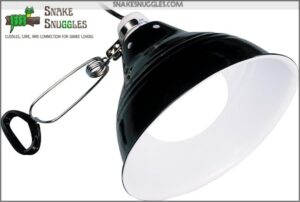
The Exo Terra Porcelain Clamp Lamp stands out as a reliable workhorse for snake heating. You’ll appreciate its heat-resistant porcelain socket that puts up with temperatures up to 150W without breaking down.
The spring-loaded clamp lets you position it exactly where your snake needs warmth. Its glow reflector coating provides subtle nighttime illumination for up to 30 minutes after switching off, perfect for nocturnal observation without disrupting your snake’s sleep cycle.
Best For: Snake owners and reptile keepers who need reliable, adjustable heating with safe nighttime visibility for monitoring their pets.
- Heat-resistant porcelain socket handles high temperatures up to 150W without degrading over time
- Spring-loaded clamp allows precise positioning and secure mounting on terrarium rims or screens
- Glow reflector coating provides subtle moonlight-like illumination for 30 minutes after switch-off, perfect for nocturnal observation
- Gets extremely hot during operation, requiring careful handling to avoid burns
- Clamp mechanism can be difficult to adjust and position properly in some setups
- Glow effect duration is limited and may not last as long as expected with heavy use
2. Fluker’s Reptile Blue Daylight Bulb
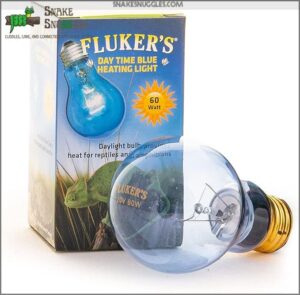
Most snake keepers appreciate this budget-friendly option that delivers reliable heat without breaking the bank. Fluker’s Blue Daylight Bulb provides essential infrared radiation through its 60-watt incandescent design, reaching about 94°F at 12 inches distance.
You’ll get UVA rays that stimulate natural feeding behavior, plus the subtle blue tint creates attractive basking zones. While some users report shorter lifespans than expected, it’s still a solid choice for beginners.
Just remember to use proper thermostats and mounting outside your enclosure to prevent burns.
Best For: Beginner snake keepers looking for an affordable daytime heating solution that provides consistent warmth and stimulates natural feeding behavior.
- Budget-friendly option that delivers reliable infrared heat at competitive pricing
- Produces UVA rays that encourage normal feeding behavior in reptiles
- Creates attractive blue-tinted basking zones while maintaining proper temperature gradients
- Some users report shorter lifespans with bulbs burning out earlier than expected
- Packaging issues may lead to damage during shipping
- Requires careful placement outside enclosure and temperature monitoring for safety
3. Fluker’s Repta Clamp Lamp Heavy Duty
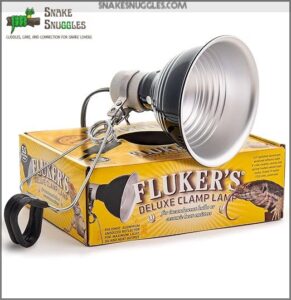
When durability matters most, this heavy-duty clamp lamp delivers reliable performance year after year. Its all-metal construction and ceramic socket ensure it won’t melt like cheaper plastic alternatives.
The secure safety clamp attaches firmly to screen-top terrariums, preventing dangerous falls. Compatible with bulbs up to 150 watts, it works seamlessly with incandescent bulbs and ceramic heat emitters.
At under $25, it’s a budget-friendly workhorse that consistently gets the job done without breaking the bank.
Best For: Reptile owners seeking a durable, heat-resistant clamp lamp that won’t melt or break under regular use with high-wattage bulbs.
- Heavy-duty all-metal construction with ceramic socket prevents melting and ensures long-term durability
- Secure safety clamp attaches firmly to screen-top terrariums, eliminating risk of dangerous falls
- Compatible with various bulb types up to 150 watts, including incandescent bulbs and ceramic heat emitters
- Not compatible with UVB mercury vapor bulbs when using dimmer function – must be kept at full power
- Some users report occasional quality control issues with faulty construction or premature bulb failure
- Limited to above-cage use only with screen-topped habitats, restricting placement options
4. Philips PAR38 Heat Lamp Bulb 175W
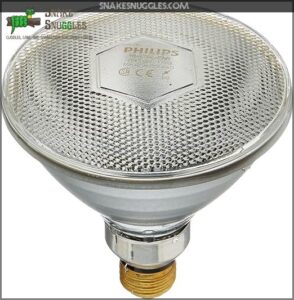
This powerhouse bulb brings industrial-grade reliability to your snake’s habitat. You’ll get 175 watts of targeted infrared heat that creates perfect basking spots for medium to large enclosures.
The hard glass construction withstands humidity while delivering up to 5,000 hours of consistent performance. It’s compatible with standard E27 fixtures and works great with dimmers for temperature control.
Just remember—this bright bulb isn’t suitable for nighttime heating since it’ll disrupt your snake’s sleep cycle.
Best For: Snake owners with medium to large enclosures who need powerful daytime basking heat and don’t mind higher energy consumption.
- Delivers strong 175W infrared heat with 5,000-hour lifespan for reliable basking zones
- Hard glass construction withstands humidity and offers splash-resistant durability
- Compatible with standard fixtures and dimmers for precise temperature control
- Bright visible light disrupts nocturnal species during nighttime hours
- Higher energy consumption compared to ceramic heat emitters or deep heat projectors
- May overheat small enclosures without proper monitoring and distance management
5. Fluker’s Ceramic Heat Emitter Reptile Bulb
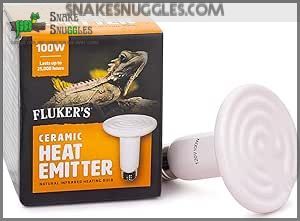
Consider Fluker’s Ceramic Heat Emitter your snake’s silent guardian. This 100-watt powerhouse delivers infrared warmth without disrupting sleep cycles—no blinding light to stress your reptile.
The large circular design spreads heat across generous basking areas, perfect for bigger enclosures. You’ll appreciate the 24-hour operation and budget-friendly price point.
However, durability varies between batches, so keep a spare handy. Always pair with a reliable thermostat for safe operation.
Best For: Snake owners seeking reliable, budget-friendly 24-hour heat without visible light that disrupts natural behaviors.
- Provides infrared heat without light emission, maintaining natural day/night cycles
- Large circular design creates expansive basking zones for bigger enclosures
- Cost-effective option with 24-hour operation capability
- Inconsistent durability with some units failing within months
- Requires compatible ceramic socket and thermostat for safe operation
- Surface gets extremely hot, posing burn risk if improperly positioned
6. Exo Terra Wire Light Small 150W
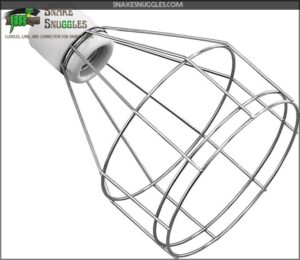
Safety meets versatility with this wire-protected fixture. You’ll appreciate the heat-resistant porcelain socket that puts up with up to 150W bulbs without breaking a sweat.
The wire guard prevents dangerous heat buildup while supporting ceramic heaters, mercury vapor bulbs, and standard incandescent options.
Installation’s straightforward with the included clamp and hanger system. Some users note the clamp feels thin, but the fixture delivers reliable heat distribution for most snake setups.
Best For: Snake owners who need a reliable, heat-resistant fixture that safely handles ceramic heaters and mercury vapor bulbs up to 150W.
- Heat-resistant porcelain socket with wire guard prevents dangerous overheating and burnouts
- Compatible with multiple bulb types including ceramic heaters, mercury vapor, and incandescent bulbs
- Includes mounting hardware with clamp and hanger for flexible installation options
- Clamp mechanism feels thin and may not provide strong enough grip for heavier setups
- Limited neck adjustability makes it harder to direct heat at specific angles
- Plastic components can become brittle over time and may crack with repeated heat exposure
7. Zacro Reptile Heat Lamp 100W
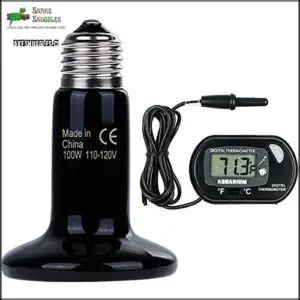
When nighttime heating becomes essential, you’ll appreciate the Zacro’s ceramic design that delivers consistent warmth without disrupting your snake’s sleep cycle. This 100W infrared emitter maintains steady temperatures while producing zero light, making it perfect for nocturnal species.
You’ll get around 2,000-3,000 hours of reliable performance, plus a digital thermometer for monitoring. The ceramic construction resists cracking under continuous heat, though you’ll need a ceramic E27 socket to prevent melting. Keep it 10-40 cm from your snake to avoid overheating.
Best For: Snake and reptile owners who need reliable nighttime heating without disrupting their pet’s natural sleep cycle.
- Zero light emission maintains natural day/night cycles for nocturnal species
- Ceramic construction provides 2,000-3,000 hours of durable, consistent heat
- Includes digital thermometer for accurate temperature monitoring
- Requires specific ceramic E27 socket to prevent melting or safety hazards
- May generate excessive heat for smaller terrariums without proper distance control
- Some users report occasional longevity issues despite advertised lifespan
Heat Lamp Safety and Maintenance Tips
You’ll want to take heat lamp safety seriously since improper setup can lead to burns, fires, or your snake’s death from overheating.
Regular maintenance and proper equipment like thermostats and lamp guards aren’t just good ideas—they’re essential for keeping your scaly friend safe and your home intact.
Avoiding Burns and Overheating
Overheating frequently causes belly burns when snakes contact surfaces exceeding 95°F. You’ll prevent this by maintaining proper lamp distance—generally 12-18 inches above basking spots. Safe wattage depends on enclosure size; start low and adjust gradually.
Monitor techniques include infrared thermometers for surface temps and digital probes for ambient readings. Setting up a python enclosure requires careful temperature control through thermostat calibration and guard usage for health and safety.
Using Thermostats and Lamp Guards
You’ll want a thermostat for temperature control and lamp guards for health and safety. Position your thermostat probe at basking spots for proper calibration.
Metal guard material works best around heat lamps. Smart placement strategies keep bulb wattage regulated while timer integration and emergency shut-off features prevent accidents. Think of these as your snake’s safety net.
Cleaning and Timely Replacement
Regular maintenance keeps your heating solutions running safely and efficiently. Clean bulb surfaces monthly with a soft cloth when cool to maintain proper heat output. Check for darkened glass or flickering—these replacement indicators signal it’s time for new bulbs.
Here’s your maintenance checklist:
- Inspect bulb wattage and connections weekly for loose fittings
- Replace incandescent bulbs every 6-8 months regardless of function
- Use safe handling practices—never touch hot glass with bare hands
- Monitor cleaning frequency based on dust accumulation in your setup
- Research proper disposal methods for different bulb types in your area
Energy efficient bulbs last longer but still need regular inspection. Most bulbs reach their bulb lifespan before burning out completely, gradually losing effectiveness. This impacts snake husbandry and your pet’s health and safety over time.
Creating an Ideal Snake Habitat
You’ll transform your enclosure into a thriving ecosystem by balancing temperature zones, humidity levels, and enrichment features that mirror your snake’s natural environment.
Think of it like designing a luxury hotel room, except your guest has specific heating preferences and won’t leave reviews on TripAdvisor.
Setting Up Basking and Cool Zones
Creating effective zones starts with positioning your basking spot at one end using proper basking surface choice. Your thermostat and temperature monitoring tools help guarantee precise temperature control across the gradient zone placement.
Species-specific needs dictate whether you’ll need 88°F or 95°F hot spots. The temperature gradient should drop 10-15°F toward the cool side, giving your snake options. Think of it like hotel room service—your snake chooses comfort levels.
Habitat decor impact matters too, so avoid blocking heat flow with decorations.
Maintaining Humidity and Substrate Quality
Your snake’s substrate choice directly impacts humidity control and thermal insulation. Keep substrate moisture balanced—too wet breeds mold, too dry hampers shedding aid.
- Monitor humidity levels between 50-60% for most species
- Replace substrate every 2-3 weeks for best cleaning frequency
- Use cypress mulch or aspen for excellent mold prevention
- Position heat mat under substrate for even thermal insulation
- Check substrate moisture weekly, especially near heat pad areas
Enhancing Comfort With Decor and Lighting Cycles
Transforming your enclosure into a cozy sanctuary involves strategic habitat setup with hiding spots and visual barriers. You’ll want naturalistic aesthetics that mimic your snake’s wild home—think rocks, branches, and plants.
Establish consistent day-night cycles using reptile lighting options, creating a reliable basking spot during active hours. Proper lighting schedules back natural light cycles, while enclosure enrichment reduces stress and promotes natural behaviors.
Frequently Asked Questions (FAQs)
How to choose a heat lamp for snakes?
Like picking the right thermostat for your home, choosing your snake’s heat lamp starts with matching incandescent bulb wattage to tank size, using a dimming thermostat for safety, and testing warmth with your hand.
What kind of light does a snake need?
You’ll need infrared heat for your snake’s basking spot, not visible light. Incandescent bulbs work best since they mimic natural sunlight’s warming rays perfectly.
Do Reptiles need a heating lamp?
Think of warmth as your reptile’s lifeline. Yes, you’ll absolutely need a heating lamp because reptiles can’t generate their own body heat.
Without proper warmth, they can’t digest food, fight infections, or maintain basic functions that keep them healthy and thriving.
Why should you choose a ceramic lamp for a snake enclosure?
Ceramic heat emitters deliver consistent warmth without light, letting your snake maintain proper nighttime sleep cycles. You’ll get reliable 24/7 heating that won’t disrupt natural behaviors.
How much does a snake lamp cost?
Sticker shock won’t hit your wallet too hard—snake heat lamps generally cost between $15-60, depending on the type and wattage you choose for your slithery friend’s comfort.
How Often Should I Be Cleaning the Lamps and Fixtures?
Clean your snake’s heat lamps weekly to remove dust buildup that blocks heat transfer. Monthly deep cleaning with a damp cloth ensures it works its best and prevents fire hazards from accumulated debris.
Is a Thermostat Necessary for Heat Lamps and Heat Mats?
Absolutely, you’ll need a thermostat for both heat lamps and mats. Without one, temperatures can spike dangerously high, potentially burning your snake or creating fire hazards that’ll keep you awake at night.
What is the price range for a reptile heat lamp?
Think of shopping for heat lamps like buying a car—you’ll find budget models and luxury options.
You can expect a lamp to cost around $10-$25 initially for basic bulbs, while complete fixtures range $30-$100+ depending on features.
Why do snakes need heat lamps?
Snakes need heat lamps because they’re cold-blooded and can’t regulate their body temperature internally. You’ll help them digest food properly, stay active, and maintain healthy immune function through external warmth.
How can I keep my reptile warm at night?
Nighttime temperatures drop 10-15°F in most homes, creating challenges for reptile owners.
You’ll want ceramic heat emitters or infrared bulbs that provide warmth without disrupting sleep cycles—they’re invisible to your snake’s eyes.
Conclusion
Your snake’s survival literally depends on getting heat right—no exaggeration needed. This buyers guide best heat lamp for snakes covers everything from ceramic emitters to deep heat projectors, but remember that your thermostat is just as important as the bulb itself.
Don’t skimp on safety features or proper placement. Your reptile friend will thank you with healthy appetite, proper shedding, and natural behaviors that make all the research worthwhile.
- https://talis-us.com/blogs/news/top-heat-lamps-for-ball-pythons-expert-recommendations-and-tips
- https://smart.dhgate.com/top-10-best-heat-lamps-for-corn-snakes-reliable-warmth-control/
- https://www.reddit.com/r/ballpython/comments/10bhnrl/what_is_the_difference_between_the_warm_side_and/
- https://reptifiles.com/heterodon-hognose-snake-care/hognose-temperatures-humidity-lighting/
- https://www.aussiepythons.com/threads/best-heat-lamp.230109/

